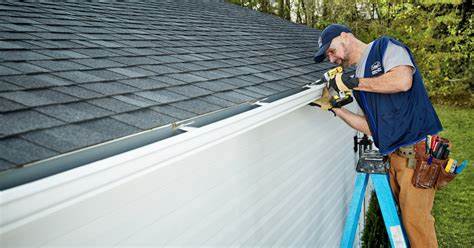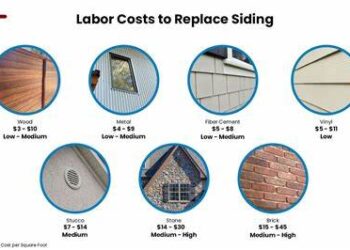When it comes to house siding installers, the right choice can make all the difference in the look and feel of your home. From boosting energy efficiency to enhancing curb appeal, the benefits are endless. Let's dive into the world of house siding installers and explore what sets the best apart from the rest.


Importance of House Siding Installation
Having proper siding installed on a house comes with numerous benefits that go beyond just aesthetics. It plays a crucial role in protecting your home from the elements and improving its overall energy efficiency and curb appeal.Benefits of Proper Siding Installation
- Weather Protection: Siding acts as a shield against harsh weather conditions such as rain, snow, and wind, preventing moisture from seeping into the walls and causing damage.
- Energy Efficiency: Quality siding helps insulate your home, reducing heat loss in winter and heat gain in summer. This can lead to lower energy bills and a more comfortable indoor environment.
- Curb Appeal: The right siding can enhance the exterior appearance of your home, increasing its resale value and making it more attractive to potential buyers.
Importance of Hiring Professional House Siding Installers
While DIY siding installation may seem tempting, it is crucial to hire experienced professionals for the job. Professional installers have the expertise, tools, and skills necessary to ensure proper installation, maximizing the benefits of siding for your home.Types of House Siding Materials
When it comes to house siding, there are various materials to choose from, each with its own set of features and benefits. Let's explore some of the most commonly used siding materials and compare their durability, maintenance requirements, and aesthetic features.Vinyl Siding
Vinyl siding is a popular choice for homeowners due to its affordability and low maintenance. It is durable and resistant to rot, moisture, and insects. Vinyl siding comes in a wide range of colors and styles, making it versatile in terms of aesthetics. However, it may not be as environmentally friendly as other materials and can crack or fade over time.Wood Siding
Wood siding provides a classic and natural look to a home. It can be painted or stained in various colors to suit different preferences. While wood siding is aesthetically pleasing, it requires more maintenance compared to other materials. Regular painting, staining, and sealing are necessary to protect it from moisture, insects, and rot.Fiber Cement Siding
Fiber cement siding is a durable and low-maintenance option that mimics the look of wood or stucco. It is resistant to fire, insects, and rot, making it a long-lasting choice for homeowners. Fiber cement siding is available in a variety of textures and colors, allowing for customization to match the style of the home.Metal Siding
Metal siding, such as aluminum or steel, is known for its durability and strength. It is resistant to fire, rot, and pests, making it a low-maintenance option for homeowners. Metal siding can be painted in different colors or finishes to create a modern or industrial look. However, it may dent or scratch easily compared to other materials.Hiring the Right House Siding Installers
When it comes to hiring house siding installers, it is crucial to choose a reputable and experienced company to ensure a successful installation process. Here are some key factors to consider when selecting the right professionals for the job.Experience and Expertise
- Look for installers with years of experience in the industry, as they are more likely to have the necessary skills and knowledge to handle your siding installation project efficiently.
- Check if the company specializes in the type of siding material you want to install, as different materials may require specific techniques and expertise.
- Ask about the training and certifications of the installers to ensure they are qualified to work on your home.
Reputation and Reviews
- Research online reviews and ratings of the siding installation company to get an idea of their reputation and the quality of their work.
- Ask for references from past clients and contact them to inquire about their experience with the installers, the quality of work, and overall satisfaction.
- Check if the company is accredited by relevant industry organizations or associations, as this can be a sign of their commitment to professionalism and quality service.
Insurance and Licensing
- Ensure that the siding installation company is properly licensed and insured to protect yourself in case of any accidents or damages during the installation process.
- Ask for proof of insurance and licensing, and verify that they are up to date and valid before hiring the installers.
- Working with a licensed and insured company gives you peace of mind and ensures that you are covered in case of any unforeseen circumstances.
The House Siding Installation Process
Installing house siding involves several key steps to ensure a successful and long-lasting result. Before the siding installation begins, there are crucial preparation works that need to be completed. The overall duration of the installation process can vary depending on the size of the house and any unforeseen challenges that may arise during the project.Preparation Work
- Inspect the exterior of the house to identify any damage or areas that need repair before the new siding can be installed.
- Clean the exterior surface thoroughly to remove dirt, debris, and any existing paint or siding materials.
- Ensure proper insulation and moisture barrier installation to protect the house from water damage and improve energy efficiency.
Installation Process
- Measure and cut the siding materials to fit the dimensions of the house accurately.
- Secure the siding panels or pieces to the exterior of the house using nails, screws, or other appropriate fasteners.
- Seal the joints and seams between the siding pieces to prevent water infiltration and improve the overall appearance.
Duration and Challenges
- The installation process usually takes several days to complete, depending on the size of the house and the complexity of the project.
- Potential challenges that may arise during the installation process include unexpected weather conditions, structural issues, or the need for additional repairs.
- It is essential to work with experienced installers who can address these challenges effectively and ensure a high-quality result.
Maintenance and Care for House Siding
Proper maintenance and care for house siding are essential to prolong its lifespan and keep your home looking its best. Regular upkeep can help prevent damage and preserve the appearance of your siding for years to come.Cleaning Different Types of Siding Materials
- Vinyl Siding:Use a mixture of water and mild detergent to scrub away dirt and grime. Avoid using harsh chemicals or abrasive brushes that can damage the surface.
- Wood Siding:Clean with a solution of water and mild soap, followed by a rinse with a garden hose. Inspect for mold or mildew growth and treat with a specialized cleaner if necessary.
- Fiber Cement Siding:Wash with a solution of water and mild detergent, using a soft brush to remove any buildup. Avoid high-pressure washing, as it can cause damage to the surface.
- Metal Siding:Clean using a solution of water and vinegar to remove oxidation and stains. Rinse thoroughly with water and dry with a soft cloth to prevent water spots.
Identifying and Addressing Common Issues
- Cracks and Gaps:Inspect for any cracks or gaps in the siding and seal them promptly to prevent water infiltration and further damage.
- Fading or Discoloration:Over time, siding may fade or discolor due to exposure to sunlight. Consider repainting or staining to refresh the appearance.
- Rot or Decay:Check for signs of rot or decay, especially in wood siding. Replace any damaged boards to prevent structural issues and maintain the integrity of your home.
- Pest Infestations:Look for signs of pest infestations, such as insect damage or nesting animals. Take appropriate measures to eliminate pests and prevent future infestations.












